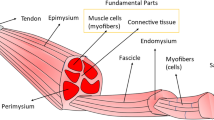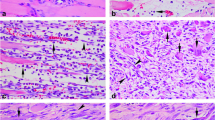Abstract
The rising incidence of mangled extremity seen in modern trauma has lead to significant patient mortality. A lot of research is going on at microcellular level for a better understanding of tissue injury, repair and regeneration. PAX-7 is one such transcription factor, a marker of satellite stem cells in skeletal muscle. Though few studies have shown concrete evidence of increased expression of PAX-7 in the nearby injured zone in skeletal muscle post-injury, none has studied its expression in an event of mangled injury of limb in humans. We, hereby, attempted to identify whether PAX-7 expression of tissue near the zone of injury, after grievous trauma like mangled injury of extremities, actually increases, decreases or remains unaffected. A pilot study was conducted on 30 cases at a level 3 trauma centre; patients were segregated into two groups—group I with MESS score ≥ 7 and group II with score < 7. For group I patients, amputation was planned, and for group II, limb salvage surgery was planned. Skeletal muscle samples from three different zones (A, B and C) in group I, while pre- and post-debridement skeletal muscle samples in group II were sent for microscopic examination and IHC staining with PAX-7 antibody. A definite increase in PAX-7 expression, post-trauma near the zone of injury (Zone B and C in group I and post-debridement in group II), was noted. Increased expression of PAX-7 signifies increased recruitment of satellite stem cells near the injury zone, thereby reflecting the activation of skeletal muscle regeneration cascade. Hence, increased staining of PAX-7 in tissues could be a viable marker for identifying potential regeneration of skeletal muscle post-injury.



Similar content being viewed by others
References
Scalea TM, DuBose J, Moore EE, West M, Moore FA et al (2012) Western Trauma Association critical decisions in trauma: management of the mangled extremity. J Trauma Acute Care Surg 72(1):86–93
Gopinathan NR, Santhanam SS, Saibaba B, Dhillon MS (2017) Epidemiology of lower limb musculoskeletal trauma with associated vascular injuries in a tertiary care institute in India. Indian J Orthop 51(2):199
Harris AM, Althausen PL, Kellam J, Bosse MJ, Castillo R (2009) Lower Extremity Assessment Project (LEAP) Study Group. Complications following limb-threatening lower extremity trauma. J Orthop Trauma 23(1):1–6
Ball CG, Rozycki GS, Feliciano DV (2009) Upper extremity amputations after motor vehicle rollovers. J Trauma 67:410–412
Bosse MJ, MacKenzie EJ, Kellam JF, Burgess AR, Webb LX et al (2002) An analysis of outcomes of reconstruction or amputation after leg-threatening injuries. N Engl J Med 347:1924–1931
Gupta A, Wolff TW (1995) Management of the mangled hand and forearm. J Am Acad Orthop Surg 3:226–236
Korompilias AV, Beris AE, Lykissas MG, Vekris MD, Kontogeorgakos VA et al (2009) The mangled extremity and attempt for limb salvage. J Orthop Surg Res 4:4
Relaix F, Montarras D, Zaffran S, Gayraud-Morel B, Rocancourt D et al (2006) Pax3 and Pax7 have distinct and overlapping functions in adult muscle progenitor cells. J Cell Biol 172(1):91–102
Yin H, Price F, Rudnicki MA (2013) Satellite cells and the muscle stem cell niche. Physiol Rev 93(1):23–67
Von Maltzahn J, Chang NC, Bentzinger CF, Rudnicki MA (2012) Wnt signaling in myogenesis. Trends Cell Biol 22(11):602–609
Birbrair A, Delbono O (2015) Pericytes are essential for Skeletal Muscle Formation. Stem Cell Rev Rep 11(4):547–548
Von Maltzahn J, Jones AE, Parks RJ, Rudnicki MA (2013) Pax7 is critical for the normal function of satellite cells in adult skeletal muscle. Proc Natl Acad Sci 110(41):16474–16479
Mackey AL, Kjaer M, Charifi N, Henriksson J, Bojsen-Moller J et al (2009) Assessment of satellite cell number and activity status in human skeletal muscle biopsies. Muscle Nerve 40(3):455–465
Lepper C, Partridge TA, Fan CM (2011) An absolute requirement for Pax7-positive satellite cells in acute injury-induced skeletal muscle regeneration. Development 138(17):3639–3646
Seale P, Sabourin LA, Girgis-Gabardo A, Mansouri A, Gruss P et al (2000) Pax7 is required for the specification of myogenic satellite cells. Cell 102(6):777–786
Hamilton DF, McLeish JA, Gaston P, Simpson AH (2013) Muscle ‘regenerative potential’ determines physical recovery following total knee replacement. Bone Jt Res 2(4):70–78
Oustanina S, Hause G, Braun T (2004) Pax7 directs postnatal renewal and propagation of myogenic satellite cells but not their specification. EMBO J 23(16):3430–3439
Seale P, Ishibashi J, Scimè A, Rudnicki MA (2004) Pax7 is necessary and sufficient for the myogenic specification of CD45+:Sca1+ stem cells from injured muscle. PLoS Biol 2(5):E130
Kadi F, Schjerling P, Andersen LL, Charifi N, Madsen JL et al (2004) The effects of heavy resistance training and detraining on satellite cells in human skeletal muscles. J Physiol 558(Pt 3):1005–1012
Kadi F, Charifi N, Denis C, Lexell J, Andersen JL et al (2005) The behaviour of satellite cells in response to exercise: what have we learned from human studies? Pflugers Arch 451(2):319–327
Sambasivan R, Yao R, Kissenpfennig A, Van Wittenberghe L, Paldi A et al (2011) Pax7-expressing satellite cells are indispensable for adult skeletal muscle regeneration. Development 138(17):3647–3656
Noehren B, Andersen A, Hardy P, Johnson DL, Ireland ML et al (2016) Cellular and morphological alterations in the vastus lateralis muscle as the result of ACL injury and reconstruction. JBJS 98(18):1541–1547
Zammit PS, Relaix F, Nagata Y, Ruiz AP, Collins CA et al (2006) Pax7 and myogenic progression in skeletal muscle satellite cells. J Cell Sci 119(Pt 9):1824–1832
Acknowledgements
This work has been funded by Indian Council of Medical Research (ICMR) (No.3/2/Sept.2016/PG-Thesis-HRD(8) Dated: 4.10.2016), Department of Health Research, New Delhi, and constituted part of a thesis submitted by the principal author.
Author information
Authors and Affiliations
Corresponding author
Ethics declarations
Conflict of interest
There are no conflicts of interest from any of the authors.
Ethical approval
The study was approved by the Institute’s Ethical Committee and was performed in accordance with the ethical standards laid down in the 1964 Declaration of Helsinki and its later amendments.
Informed consent
Informed consent was taken from the patients at the time of enrolment and the study procedure was explained in detail to all the enrolled patients and they were made to understand that they could withdraw from the study at any point of the study period. The study has not altered any of the management protocols of these patients. Identity of the participants was kept confidential.
Additional information
Publisher's Note
Springer Nature remains neutral with regard to jurisdictional claims in published maps and institutional affiliations.
Rights and permissions
About this article
Cite this article
Kansal, R., Kanojia, R.K., Kumar, V. et al. Role of PAX-7 as a tissue marker in mangled extremity: a pilot study. Eur J Orthop Surg Traumatol 29, 1131–1140 (2019). https://doi.org/10.1007/s00590-019-02410-w
Received:
Accepted:
Published:
Issue Date:
DOI: https://doi.org/10.1007/s00590-019-02410-w




